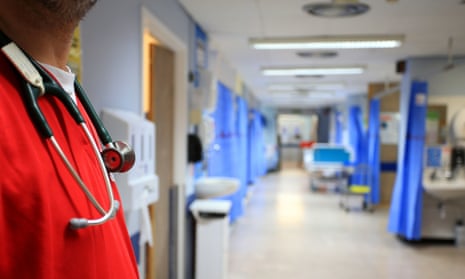“I will deliver on the National Health Service” was as much detail as the new prime minister offered on health policy in her victory speech on Monday. One idea floated during her campaign, that £13bn of new funding earmarked for the NHS should be diverted to social care, might once have won plaudits. But such is the crisis now engulfing hospitals that the moment has passed. Next week, a ballot opens that could see nurses in England and Wales go on strike for the first time. A record 132,139 – or almost 10% of all NHS posts – were vacant in June.
Never mind the warm words from ministers, particularly during the pandemic. The fact is that the service has gone from rude health to the brink of collapse in a decade. The increase in the number of vacancies by more than 26,000 in three months has alarmed even those well-versed in the sector’s staff shortages. With around 10% of care home posts also unfilled, the UK is facing an unprecedented workforce collapse (the previous highest number of NHS vacancies was 111,864 in 2019).
Evidence of what this means on the ground is everywhere. While hospitals and clinics are short-staffed, meaningful progress on cutting NHS England’s record waiting list is impossible (the health services of Northern Ireland, Scotland and Wales also have huge backlogs). Waiting times for ambulances and in A&E departments are longer, and people cannot get appointments with GPs. In care homes, residents are neglected when there is no one to care for them. The overall effect is that it is less safe to be frail or ill.
A plan based on demand modelling is what is needed – and has been for years. Jeremy Hunt knows it, although unfortunately didn’t when he was health secretary and could have done something about it. The health workforce shortage is a global problem, as populations age, and a combination of environmental factors such as obesity and advances in medical technology make care more complex. But the UK’s problem has become acute.
One reason is Brexit, and the number of NHS staff who returned to EU countries (around 10,000 left in three years after the referendum). Another is our centralised system. Because we have a national health service, the government bears more direct responsibility for healthcare, including staffing, than in many other countries. A third factor is the size of the UK’s population and healthcare workforce. A fourth is the caps placed on training places in 2012, to save money.
Having promised a NHS people plan back in 2018, the Conservatives have refused to deliver it because they are afraid of the cost. The consequences of this failure, combined with delays in addressing the chronic underfunding of social care, are increased suffering and danger. Currently, around one in seven hospital beds are occupied by people who can’t be discharged because there is nowhere for them to go.
Faced with warnings of a “horrible winter” and recognising the political risks, ministers have directed a frenzy of recruitment from outside the EU. As well as being short-termist, this brings ethical problems. Nepal and Nigeria, both targeted by employers, are on a World Health Organization red list, which is supposed to prevent the stripping of human resources from poorer nations by richer ones. Unless Liz Truss’s government changes course, it is more destruction – and not the “potential” she enthuses about – that looks set to be unleashed.
